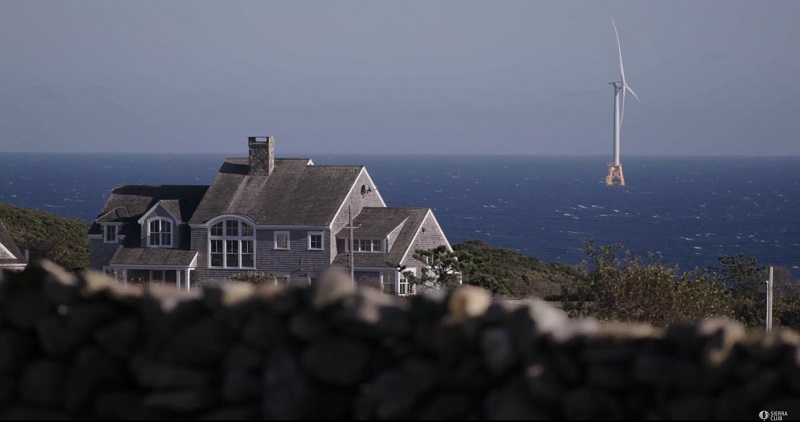North Carolina has long been known for its beautiful beaches, which draw more than 12 million visitors and related revenue each year. But its 320 miles of oceanic shoreline could soon feature a new attraction – offshore wind energy.
A 2021 study by the N.C. Department of Commerce anticipates that U.S. East Coast offshore wind capacity will exceed 40 gigawatts (GW) by 2035. North Carolina alone is expected to reap more than $100 billion from supply chain manufacturing, installation, and energy generation.
 Gov. Roy Cooper has issued two executive orders on clean energy in the past four years, leaving North Carolina poised to take advantage of wind energy’s plentiful economic and environmental benefits.
Gov. Roy Cooper has issued two executive orders on clean energy in the past four years, leaving North Carolina poised to take advantage of wind energy’s plentiful economic and environmental benefits.
The most recent executive order calls for developing 2.8 GW and 8.0 GW of coastal wind capacity by 2030 and 2040, respectively. Meeting these goals would power more than two million homes with fossil-free, renewable energy and help our state reach its Clean Energy Plan targets: 70 percent reduction (from 2005 levels) in power sector greenhouse gas (GHG) emissions by 2030 and carbon neutrality by 2050.
Offshore wind development would also help meet the goals approved by Cooper and the General Assembly in 2021, requiring the N.C. Utilities Commission (NCUC) to adopt a plan to reduce carbon dioxide (CO2) emissions by 70% by 2030 and achieve carbon neutrality by 2050.
In May 2022, Duke Energy filed a draft carbon plan - still under review - with the NCUC. This Integrated Resource Plan for the first time included offshore wind scenarios. But its proposals don't go nearly far enough, with two frameworks for offshore wind development in the next decade that call for no more than 1.6 GW of generation. Two of its four suggestions for an energy mix portfolio include offshore wind, but no more than 2.4 GW by 2035.
Right now, the state has two offshore wind projects in the early stages of development. The first, Kitty Hawk Offshore, would be located in a 200-square-mile wind energy area more than 27 miles off the coast of the northern Outer Banks. The site is leased by Avangrid Renewables, which operates the onshore Amazon Wind Farm in Perquimans and Pasquotank counties. Construction is expected to begin in the next few years and, once operational, Kitty Hawk Wind is expected to produce around 2.5 GW of clean energy – enough to power nearly 700,000 homes.
The second, Wilmington East/Carolina Long Bay, was auctioned and leased in May 2022 for $315 million. This 172-square-mile area is divided into two sections that were leased by TotalEnergies Renewables USA and Duke Energy Renewables Wind. If ultimately developed, the areas could generate more than 1.3 GW, enough to power about 500,000 homes. But it could take as much as eight years for installation to begin due to the lengthy siting assessment and approval process, the Bureau of Ocean Energy Management (BOEM) says.
But can development of North Carolina's abundant offshore wind resouces coexist with our coast's tourism-dependent economy? Evidence from studies and existing offshore wind energy sites indicate that not only can they coexist, but that wind development may even boost visitation.
North Carolina’s sites are no closer than 17 nautical miles offshore. Recent simulations of Wilmington East show 850 foot turbines appearing as mere specks on the horizon – hardly visible from shore.
In Europe, where offshore wind projects have operated for more than three decades well within view of coastlines, numerous case studies show that turbines have benefited coastal economies and increased visitation.
 In the United States, researchers at the University of Rhode Island analyzed AirBnB rental data before and after construction of the Block Island Wind Farm (pictured), the only operational offshore wind site in our nation. Rental trends during the peak summer months were almost entirely positive, with a 19 percent increase in occupancy and a $3,000 increase in monthly revenue in 2019, the first year after construction.
In the United States, researchers at the University of Rhode Island analyzed AirBnB rental data before and after construction of the Block Island Wind Farm (pictured), the only operational offshore wind site in our nation. Rental trends during the peak summer months were almost entirely positive, with a 19 percent increase in occupancy and a $3,000 increase in monthly revenue in 2019, the first year after construction.
While no energy source is without costs and impacts, clean energy provides hope for a future without the disastrous impacts of climate change and sea level rise. Developed and sited correctly, offshore wind can be a boon to North Carolina in many ways - for our climate, our environment, our health, our economy, our communities - and our future.